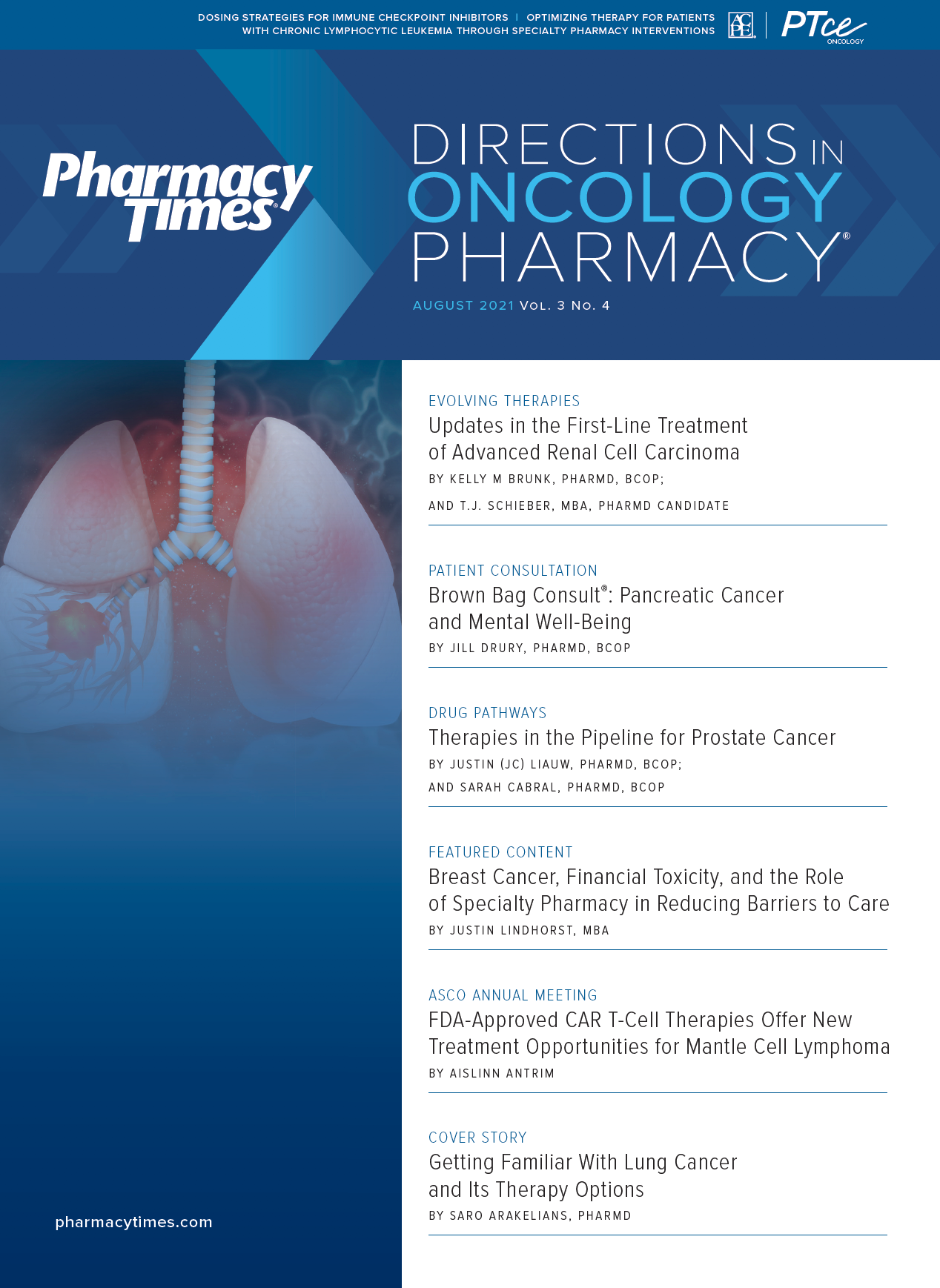Publication
Article
Pharmacy Practice in Focus: Oncology
Getting Familiar With Lung Cancer and Its Therapy Options
Author(s):
A number of prescription medications are indicated for the treatment of this aggressive disease.
Lung cancer is an aggressive form of cancer that is one of the leading causes of death worldwide and in the United States. This disease may affect anyone, including smokers and nonsmokers. However, the rate of cancer in those with no smoking history is lower.1
Lung cancer was first identified in 1761 as a distinct disease, although the disease was still rare through the 19th century. In 1929, German physician Fritz Lickint first recognized the potential connection between lung cancer and smoking. The American Cancer Society linked smoking and cancer by 1954 and, a decade later, the US Surgeon General declared smoking a cause for lung and laryngeal cancers.2
Lung cancer today is the third most common cancer in the United States, after skin cancer and breast cancer among women and prostate cancer among men. That said, lung cancer causes more deaths than any other cancer in the country.3 In 2017, there were more than 220,000 new cases of lung cancer reported and about 140,000 people died of this cancer. In other words, for every 100,000 people, 55 new lung cancer cases were reported and 37 of them died of this cancer.4
Lung cancer can be divided into 2 main types: non–small cell lung cancer (NSCLC) and small cell lung cancer (SCLC). About 85% of the lung cancers are the NSCLC type, including adenocarcinoma, squamous cell carcinoma, and large cell carcinoma. Such types are grouped together since their prognoses are typically similar. Adenocarcinomas starts in the cells, mainly in current or former smokers, although they can also occur in nonsmokers. It is more common in men and younger populations. Squamous cell carcinoma begins in squamous cells, which line the inside airways of the lungs, near the bronchi. Large cell carcinomas can appear in any part of the lungs.5
SCLC occurs in about 15% to 20% of the population. This type of cancer grows faster than NSCLC and responds well to chemotherapy and radiation therapy. However, in the majority of cases, SCLC relapses. Other types of cancer may include lung carcinoid tumors, adenoid cystic carcinomas, lymphomas, sarcomas, and hamartomas.4
Lung cancer typically does not have any symptoms in the early stages, which present themselves in the advanced stages. These signs and symptoms may include cough, coughing up blood, shortness of breath, chest pain, weight loss, bone pain, headache, and hoarseness.4
Medications approved to treat NSCLC include paclitaxel (Abraxane; Bristol Myers Squibb), palbociclib (Ibrance; Pfizer), alectinib (Alecensa; Genentech), bevacizumab (Avastin; Genentech), carboplatin (Paraplatin; Bristol Myers Squibb), ceritinib (Zykadia; Novartis), ramucirumab (Cyramza; Eli Lilly and Company), docetaxel (Taxotere; Sanofi and Aventis), erlotinib (Tarceva; Genentech), gemcitabine (Gemzar; Eli Lilly and Company), durvalumab (Imfinzi; AstraZeneca), pembrolizumab (Keytruda; Merck), lorlatinib (Lorbrena; Pfizer), nivolumab (Opdivo; Bristol Myers Squibb), necitumumab (Portrazza; Eli Lilly and Company), selpercatinib (Retevmo; Eli Lilly and Company), atezolizumab (Tecentriq; Genentech), vinorelbine (Navelbine; Pierre Fabre Pharmaceuticals), and ipilimumab (Yervoy; Bristol Myers Squibb).
When it comes to combination medications for non–small cell lung cancer, 2 options are carboplatin and taxol; and gemcitabine and cisplatin (Platinol; Bristol Myers Squibb). Medications approved for small cell lung cancer may include durvalumab, etoposide (VePesid; Bristol Myers Squibb), everolimus (Afinitor; Novartis), nivolumab, atezolizumab, methotrexate (Rasuvo; Medexus Pharma), and lurbinectedin (Zepzelca; Jazz Pharmaceuticals and PharmaMar).6
The most recent addition to this list of medications is amivantamab (Rybrevant; Janssen), which was approved in late May 2021 by the FDA. This drug is a bispecific epidermal growth factor receptor (EGFR)-directed and mesenchymal-epithelial transition (MET) receptor-directed antibody indicated for the treatment of adult patients with NSCLC with EGFR exon 20 insertion mutations.
Amivantamab comes in a 350 mg/mg (50 mg/ml) solution, packaged in a single-dose vial. The most common adverse effects in clinical trials included rash, musculoskeletal pain, dyspnea, nausea, fatigue, edema, stomatitis, cough, constipation, and vomiting. Amivantamab can also create some laboratory abnormalities, such as decreased lymphocytes, decreased albumin levels, decreased phosphate, decreased potassium, and increased alkaline phosphate levels.7
With such new medications in the market adding to the variety of options for patients with diagnosed lung cancer, there is a hope for better clinical outcomes, fewer adverse effects, and better prognoses and survival for these patients. With the research advancing on lung cancer, more targeted therapies will be studied in the near future so patients suffering from this debilitating disease can benefit from their effects.
ABOUT THE AUTHOR
Saro Arakelians, PharmD, is a vice president of pharmacy operations, population health management, and chronic health conditions in the Los Angeles area, and a graduate of Northwestern University.
REFERENCES
1. Lung cancer. Mayo Clinic. March 23. 2021. Accessed June 4, 2021. https://www.mayoclinic.org/diseases-conditions/lung-cancer/symptoms-causes/syc-20374620
2. Lung cancer: history and hope. Top Masters in Healthcare Administration. Accessed June 4, 2021. https://www.topmastersinhealthcare.com/lung-cancer/
3. Lung cancer statistics. Centers for Disease Control and Prevention. Reviewed September 22, 2020. Accessed June 4, 2021. https://www.cdc.gov/cancer/lung/statistics/
4. Leading cancer cases and deaths, all races/ethnicities, male and female, 2017. US Cancer Statistics. June 2020. Accessed June 4, 2021. https://gis.cdc.gov/Cancer/USCS/DataViz.html
5. What is lung cancer? American Cancer Society. Revised October 1, 2019. Accessed June 4, 2021. https://www.cancer.org/cancer/lung-cancer/about/what-is.html
6. Drugs approved for lung cancer. National Cancer Institute. Updated March 12, 2021. Accessed June 4, 2021. https://www.cancer.gov/about-cancer/treatment/drugs/lung#1
7. Rybrevant. Prescribing information. Janssen; 2021. Accessed June 4, 2021. https://www.janssenlabels.com/package-insert/product-monograph/prescribing-information/RYBREVANT-pi.pdf







